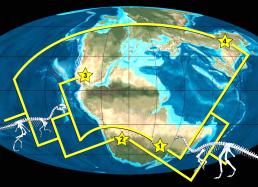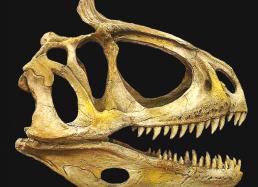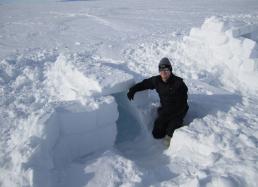FAQ's
During the expedition, Nate responded to the most frequently asked questions that he and Pete received from viewers via Facebook. Check out the questions and answers below!
1) Where do you sleep, eat, go to the bathroom, and shower?
From James Guthrie
Hello, James! At McMurdo, we’re assigned dorm rooms, where we have beds and shared bathrooms in each hall. Out in the field, we’ll camp in tents, sleep on cots, and use special bathrooms—no showers, though. But we really don’t need them. You don’t have much of a sense of smell when it’s that cold and dry out, and H20 in liquid form is at a premium for drinking and cooking. Check out our Camp Life Photo Gallery to see photos from our last trip, and stay tuned for videos from the field showing more about our accommodations.
2) What do you eat there? Is it astronaut food, or do you get to eat anything real?
From Joanne Johnson, Sycamore Junior High
Hi Joanne! I have some family out in Sycamore—shout out to the Binders and Smiths! At McMurdo station we actually eat really well. There’s one main cafeteria that serves food to everyone on the station, and the chefs work very hard to keep things interesting and delicious. You burn a lot of calories out in the cold, so it's critical to get those back at meal times (this is why we always make sure to stop by the ice cream machine after dinner). Staying hydrated is important as well, so there are plenty of beverages available.
Our remote Beardmore Camp will have a cook staff of three people to help feed the 60 or so scientists and staff, but we’ll also be doing some of our own cooking. We’ve even made pizza at camp before! We do have some dehydrated food packs (similar to astronaut food), but we use those only if we're going to set up a smaller campsite for a few days, away from the Beardmore Camp, and only if gear/equipment weight is an issue.
3) Just how cold does it get, and does it stay more or less the same temperature since the sun is always shining these days?
From Sara ElShafie
Hi Sara, good to hear from you! The temperature can vary quite a bit, but it’s more dependent on cloud cover, atmospheric pressure, and how much wind we're getting than differences between night and day. The weather at McMurdo can be beautiful (pushing 30° F), but average temps here are typically around 15° F or so, and with the wind chill, they can get down to 0° F or below. Our remote Beardmore Camp will be a bit colder, and our actual field sites (which are higher in altitude) can get down to –25° F and even lower.
4) Did dinosaurs in Antarctica go extinct with the general mass extinction [that occurred at the end of the Dinosaur Age] or was it because their land mass drifted south into the colder weather?
From Melanie An
Hi Melanie! Your question is a good one. We actually can’t say too much about how the Cretaceous-Tertiary (K/T) mass extinction (~65 mya) affected dinosaurs in Antarctica, because we really don’t have a good rock record from that time on the continent. In the area where we're working in the Central Transantarctic Mountains, the youngest preserved rocks that contain land animals are from the Early Jurassic period (~190 mya). Much of the record after that time is missing from this portion of the Transantarctic Mountains.
Several species of dinosaur are known from Cretaceous rocks on the Antarctic Peninsula (See our Antarctic Fossils Photo Gallery), but we still don’t have a great record of the extinction boundary in this area. What we do know is that Antarctica was relatively hospitable for dinosaurs for a long period of time in the Mesozoic age, and much of the climate that characterizes Antarctica now didn’t become that way until well after the K/T mass extinction.
By collecting more fossils from Antarctica, we’re hoping to gain a better understanding of how this continent’s fauna has changed through time, but answering really big questions—such as the causes of major mass extinctions in Earth's history—requires a multi-faceted approach, combining information from paleontology, geology, biology, ecology, climatology, and geography; which is part of what makes such questions so exciting!
5) Dinosaurs? Are you kidding me? Dig in Antarctica and you're likely to wake up the Old Ones—haven't you read "At the Mountains of Madness" by H.P. Lovecraft?
From Jeff Gill
Antarctica is an extremely treacherous place, but there’s only one thing here that truly scares us, and that is the dreaded Beardmore Glacier Gorilla. We’re not saying that the Beardmore Glacier Gorilla is a murderer. We’re only saying that he has killed before…and will kill again….
6) What was it like to sleep in your “snow cave” overnight?
From Jenny Johnson, East Jessamine Middle School
I have to admit I was quite excited by the idea of sleeping in a snow shelter. We were definitely lucky in having a very warm day (by Antarctic standards) when we built and slept in the shelters. The hardest part was getting into and out of the sleeping bag. The shelter is rather narrow and confined by design, because you don’t want to have to warm up too large a space with your body heat. This means that you end up easily knocking off some snow from the walls or roof as you get undressed and wriggle into your sleeping bag.
You have to take off your outerwear before getting into the sleeping bag, otherwise the snow and ice that have stuck to your clothing will melt, making the bag wet and you cold. This meant I was pretty cold getting into my bag, and it took me a long time (at least it felt like a long time) to warm up. Once I got warm, however, I slept quite well and actually had to be woken up in the morning, as it’s pretty quiet when you’re four feet under the surface of the snow.
7) Has anyone had altitude sickness yet?
From James Dykestra
We had a couple of instances where a member of the Kirkpatrick team got an altitude headache, but no symptoms worse than that. In both cases, the person involved was on their first or second day at altitude, so their bodies had not yet adjusted to the lower oxygen levels. Both times, the symptoms happened late in the afternoon, and the person in question just took it easy and avoided exertion until the helicopters arrived to take us back to camp, which was 6,000 feet lower in altitude.
8) Is the “30-30-30 Rule of Survival” real or a myth? (Exposed flesh in -30F air with a 30 MPH wind will freeze solid in 30 seconds.
From John M. Dantzler
While we didn’t hear that specific rule in survival school, we were certainly warned about how quickly frostbite can occur and about how wind chill can dangerously accelerate the freezing of exposed tissues. Another concern is contact frostbite. Touching frozen metal or spilling fuel on oneself in such temperatures can lead to instantaneous frostbite.
A particular experience I had on Mt. Kirkpatrick certainly leads me to believe that the 30-30-30 Rule is correct. On one of the first days at the quarry, I wanted to shoot a video of the helicopter taking off from our landing zone. The outside temperature was about -26C (-15F). Since the helo was taking off shortly after dropping us off, I removed one of my gloves in order to pull the video camera out of its pouch and operate it.
As I was shooting footage of the helicopter taking off, the rotor wash hit me at considerable velocity, generating an instant wind-chill effect. I could feel the tips of my ring finger and pinky going numb, so I quickly put away the camera and placed my hand in my armpit. (Skin-to-skin contact is the recommended way to treat frostnip/bite.) It took about ten very painful minutes for my digits to get back to normal. That experience taught me to be very aware of the dangers of frostbite.
9) What are the research projects of some of the other scientists you have met?
From Lauren Eaves
Numerous geological, glaciological, and meteoritics projects were based out of the Central Transantarctic Mountain camp. In addition to our project, paleontology was represented by a large team of paleobotanists led by Tom and Edith Taylor from the University of Kansas. They were principally focused on collecting fossil plant parts, including leaves, wood, and cuticles from Triassic localities.
Another University of Kansas team, led by Steve Hasiotis, was interested in trace fossils from the same time period. Two teams from the University of Ohio were studying the depositional environments of the Permian and Triassic rocks in the area to better understand the extent of glaciation during the Permian period, when the Earth went through a massive ice age. Two teams were searching glacial moraines for ‘erratics’—out-of-place rocks that had been brought to the surface by ice flowing from the polar plateau—which can reveal something about the geology of the rocks buried under the kilometers of ice that cover the interior of the continent.
There were also teams that searched the ice sheets for meteorites, botanists looking for lichens (which are the only organism that can live in those inhospitable climates), and an international team of geophysicists led by scientists from the University of Utah who were mapping the rocks under the ice sheet by using arrays of very sensitive instruments.
Although most of the teams were based at U.S. institutions, a large number of teams were based in New Zealand. There was also a strong international component to the camp, with scientists from Canada, South Africa, Japan, and Australia, in addition to Americans and New Zealanders.
10) Find any blind 6 ft tall penguins amongst ruins millions of years old? If you read H.P. Lovecraft, you know what I'm talking about.
From Gary Perlmutter
I must confess to not having read the book, so I can’t relate to the analogy, but penguins were definitely on my list of must-see goals for the trip. With the exception of skuas (a large and aggressive gull-like bird) vertebrate animals feed in the ocean in Antarctica. Therefore we didn’t see any life forms, with the possible exception of some lichens in the Central Transantarctic Mountains.
Because the sea ice was still solid during the early part of our trip, I didn’t see any penguins until later, we returned to McMurdo. By that time, the ice was broken (with some assistance from a Swedish ice-breaker), so I got to see an Adelie penguin just off Hut Point. More surprisingly, there was a flock of about ten Emperor penguins that were hanging out along the road between McMurdo and the Pegasus ice runway, several miles from open water and fishing. I’m not sure if and how they were feeding, but they can live off their fat reserves for extended periods of time.
11) It must be scary to have to get so close to the fossil with the rock saw...not knowing whether something else, unmapped, down there might be harmed or destroyed.
From Gail Cotton
Unfortunately, we do have to make cuts and drill holes, some of which end up going through fossil bone. The bones are very close together, but are located in a volume of rock far too big to excavate as a single block, so we’re forced to break it into smaller blocks. (The maximum weight that the helicopters can carry off the mountain is 800 lbs.)
We try to be as careful as possible and avoid bones, or we try to sacrifice bones that are already incomplete or of lesser significance (e.g. ribs), but to some degree, the nature of the rock dictates how we proceed. We are fortunate that the rock is very hard and that the bones are well permineralized, so they tend to fracture along clean breaks that fit together once the bones are prepared back in the lab.
12) Looks like fun but am wondering what method is used to estimate age. Carbon 14 only works to about 30,000 years so what’s used in the million range?
From Fred Wheeler, Lima, Peru
Currently we have only an approximate age for the fossils. This age estimate is bounded in part by the age of the basalts that lie on top of the Hanson Formation. These volcanic rocks have been dated at just under 180 million years using isotopes from the uranium-to-lead decay series. It works along a similar principle as C14 dating, but unlike C14 which has a half life of about 16,000 years, uranium has a half life in the billions of years, which allows us to date much older geologic events.
The current date is further refined by looking at the fossil record of the animals that are known from the Mt. Kirkpatrick quarry. By comparing the age distribution of animals from the same lineages that are found elsewhere on the planet, we can bracket the age of the Kirkpatrick fauna. The current age estimate of 200-180 million years maximizes the age overlap between the lineages represented by the Kirkpatrick fossils, especially Cryolophosaurus, Galcialisaurus, and the large tritylodont.
This season we collected samples from a sandstone that is a few meters above the quarry, in which we hope to finds small zircon crystals. The zircons can be used for dating using uranium-to-lead decay and will hopefully give us a more precise date than the current range we have. Because the sandstone is slightly above the dinosaur quarry and therefore younger, any date we get would represent a minimum age for our animals.




